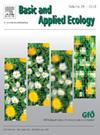Warming enhances the effects of nitrogen addition on fungal but not on bacterial diversity in an alpine meadow
IF 3.5
2区 环境科学与生态学
Q2 ECOLOGY
引用次数: 0
Abstract
Warming and nitrogen (N) deposition significantly affect soil microbial community characteristics. However, the responses of bacterial and fungal diversity to warming and N deposition, as well as the dominant influencing factors, remain unclear, especially in N-limited and low-temperature ecosystems. We employed a field-controlled experimental design with warming (W, using open-top chambers at +2 °C), N addition (N, 40 kg N ha−1 yr−1 NH4NO3), and their interaction (NW) to simulate their effects on soil microbial community composition and diversity, as well as plant community characteristics. Our results showed a significant decrease in bacterial richness (Chao1) under warming. N addition had a positive effect on bacterial richness (Chao1) but a negative effect on fungal diversity (Shannon and Chao1), which led to a considerable shift in bacterial community composition. Conversely, N addition combined with warming significantly increased fungal diversity but decreased bacterial diversity compared with N addition alone. Bacterial diversity was positively influenced by soil moisture but negatively affected by soil temperature and forb dominance. Fungal diversity was negatively influenced by soil NH4+-N content and belowground biomass. Additionally, our results showed a synergistic effect on fungi owing to changes in plant community composition, while an antagonistic effect on bacterial diversity was observed owing to reduced water and nutrient availability under warming plus N addition. Our findings underscore the importance of considering plant productivity and diversity when examining microbial diversity responses to warming and N addition in alpine meadows.
气候变暖增强了氮添加对高山草甸真菌而非细菌多样性的影响
增温和氮沉降显著影响土壤微生物群落特征。然而,细菌和真菌多样性对增温和氮沉降的响应及其主要影响因素尚不清楚,特别是在限氮和低温生态系统中。采用田间对照试验设计,模拟增温(W, +2°C开顶箱)、N添加(N, 40 kg N ha - 1 yr - 1 NH4NO3)和它们的相互作用(NW)对土壤微生物群落组成和多样性以及植物群落特征的影响。结果表明,增温条件下细菌丰富度(Chao1)显著降低。添加氮对细菌丰富度(Chao1)有正向影响,但对真菌多样性(Shannon和Chao1)有负向影响,导致细菌群落组成发生较大变化。相反,与单独施氮相比,增温加氮显著增加了真菌多样性,但降低了细菌多样性。土壤湿度对细菌多样性有正向影响,土壤温度和牧草优势度对细菌多样性有负向影响。土壤NH4+-N含量和地下生物量对真菌多样性有负向影响。此外,我们的研究结果表明,由于植物群落组成的变化,真菌具有协同作用,而由于增温加氮降低了水分和养分的有效性,细菌多样性受到拮抗作用。我们的研究结果强调了在研究高寒草甸微生物多样性对增温和氮添加的响应时考虑植物生产力和多样性的重要性。
本文章由计算机程序翻译,如有差异,请以英文原文为准。
求助全文
约1分钟内获得全文
求助全文
来源期刊

Basic and Applied Ecology
环境科学-生态学
CiteScore
6.90
自引率
5.30%
发文量
103
审稿时长
10.6 weeks
期刊介绍:
Basic and Applied Ecology provides a forum in which significant advances and ideas can be rapidly communicated to a wide audience. Basic and Applied Ecology publishes original contributions, perspectives and reviews from all areas of basic and applied ecology. Ecologists from all countries are invited to publish ecological research of international interest in its pages. There is no bias with regard to taxon or geographical area.
 求助内容:
求助内容: 应助结果提醒方式:
应助结果提醒方式:


